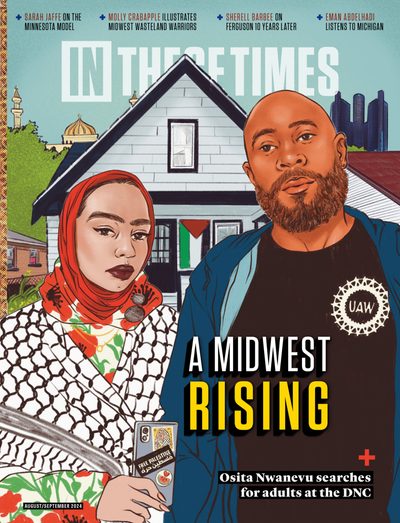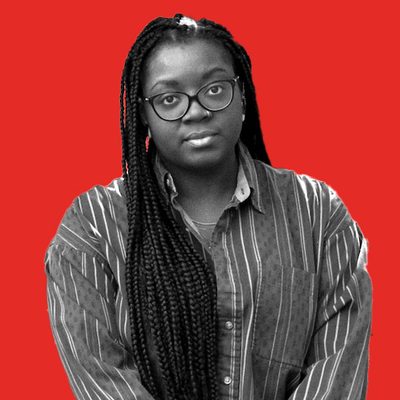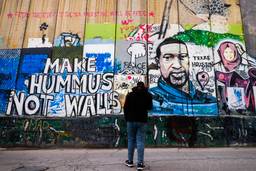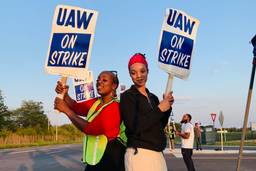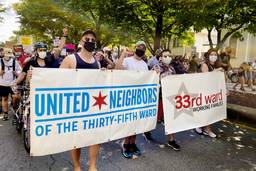Reflections on the 10-year Anniversary of the Ferguson Protests
I don’t blame Michael Brown for having a smoking habit. Nor will I blame the boy for stealing a pack of smokes on August 9, 2014.
Sherell Barbee and Jacqui Germain
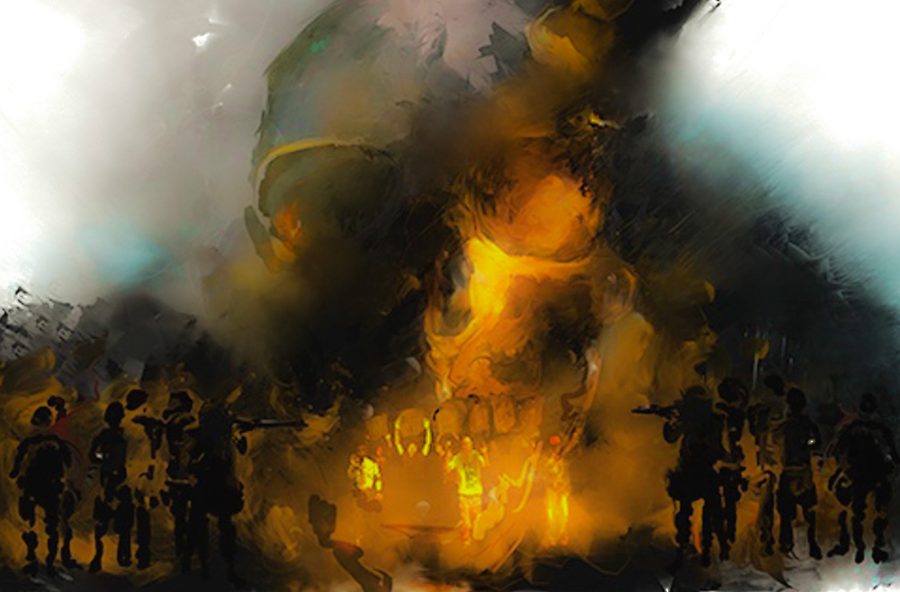
If you drive up West Florissant Avenue, heading north away from the Gateway Arch, and make a right onto Canfield Drive — past the trees lining Windward Court, past where the kids used to play double Dutch and hopscotch along Glen Owen Drive, past where they huddled for games of tag and hide-and-seek along Bahama Court — you’ll find a secret entrance to a creek.
It’s a place where, in spite of our parents’ warnings, we couldn’t help but flock to as kids. It was our oasis within the city. A place where we’d settle our childish disputes with quick splashes of water aimed at each other. A place where we’d let loose and explore the wondrous trees, rocks and critters lurking among the moss. Every so often, we’d grab slices of bread from our homes to feed the ducks that swam along the stream. And some mornings when we were running late, we’d take a shortcut through the creek to make it to school on time. The muddy walk — which entailed a short descent down a rocky wall, a tiptoe across a stream via makeshift bridge and a brief climb up again, onto the far edge of Koch Elementary’s field land — cut our commute to school down by a couple minutes.
My mother moved us from Chicago back to her hometown in St. Louis to be closer to family after a failed marriage with my father. She wanted to stay in North St. Louis County, the predominantly Black suburban ring surrounding northern St. Louis. Dating back to the Jim Crow era, it is still rare for Black people in St. Louis to live south of Delmar Boulevard, the street once redlined to separate the Black North and white South from integrating. After scouring the area for decently priced vacancies in a safe area in North County, my mother landed on a three-bedroom ranch-style apartment in Ferguson, Mo.
When I reminisce about the six years I lived in Ferguson— from ages 4 to 10, between 2000 and 2006 — childhood adventures among a community of families are at the top of my mind. It was a neighborhood where it wasn’t uncommon to receive a knock on the door from someone in need of a cup of sugar for a last-minute recipe, or an iron to press out wrinkles before picture day. A place where kids walked home from school in small groups and spent hours playing together after school, biking from one friend’s home to another until the streetlights came on.
Sometime around fourth grade, a noticeable shift rippled through the neighborhood. Everyone received a notice detailing an update to their lease terms, something about needing to vacate the premises by the end of next summer if you made too much money. Looking back as an adult, I see the picture sharpen: At the time, Section 8 was expanding amidst the demolition of public housing, and some private landlords chose to specialize in Section 8 because it was guaranteed monthly revenue from government subsidies. (I won’t get into the details of the obvious legacy of redlining and historical racism in the name of “urban renewal,” which further drove down low Black homeownership rates and pushed people into concentrated areas of poverty through Section 8 communities.)
The effect of the notices was like a cleaver, laying bare the distinct class divide in the neighborhood: those being told to move out because their income was too high, and those who had no choice but to stay. The implications weren’t lost on me and my friends, as whether or not one was moving became a main topic of conversation among us kids, exposing who was living below the poverty line and who would soon move on to presumably bigger homes in better neighborhoods with better schools.
Over the summer of 2006, the neighborhood — once an economically diverse enclave — slowly became, household by household, home to a lower class for whom EBT and WIC were a reality. And for whom disenfranchisement and disinvestment were too. By summer’s end, my mother bought our next house, a couple of suburbs away.
I’d return to the old Ferguson neighborhood as a teenager — once on a nostalgic drive soon after I got my driver’s license just to see how the old neighborhood held up, then again to protest against the state-sanctioned murder of a teenage boy named Michael Brown. On both trips, I couldn’t help but notice how things had changed: that the communal playground had been removed and the community pool filled with cement, removing two pivotal third spaces that once served the neighborhood’s residents with a small reprieve from the stresses of daily life. Two of the area’s school districts, Riverview Gardens and Normandy— from which Michael Brown had graduated just weeks before he was killed — had lost their state accreditation, weakening the value of receiving a high school diploma from the district. (When an old friend who graduated from Riverview Gardens High School went to college, he was automatically put on academic probation, because he had graduated from an unaccredited high school.)
This was the climate in which, 10 years ago this August, police officer Darren Wilson fatally shot an unarmed, teenaged Brown, at least six times in his hand, arms, chest and head, less than 90 seconds after first encountering him. Brown’s body lay in a pool of his own blood for four hours out in the open of Canfield Drive, uncovered from the muggy summertime heat on a Saturday afternoon. Dozens of residents had full view of this modern-day lynching from their windows. From the time of Brown’s death at 12:02 p.m. to the time his body was removed from the scene four hours later, at least 44 police units were dispatched upon the neighborhood, including at least four canine units and a SWAT team.
All this is to say that I don’t blame Brown for having a smoking habit. Nor will I blame the boy for stealing a pack of smokes on Aug. 9, 2014. The events surrounding Ferguson tell the sum of many American-made systems of neglect, a community’s attempt to protest an unjust murder, and how that protest was met with tax-funded brutality from a militarized police force — including the continued imprisonment of protester Josh Williams, who was taken into prison at age 19 and is still there today, 10 years later.
Below, I’m excited to share poetry by St. Louis-based writer Jacqui Germain, who brings us back to the terror of that summer. With gut-hitting words, she forces us to taste the raw kick of a police boot, to feel the panicked thump-thump in our hearts when a U.S.-made tear gas canister lands between our feet, acrid and hot in our eyes. Oh America, ‘tis of thee.
ON THIS DAY
for Antonio Martin
The clouds pulled
apart from themselves
like a damp napkin splitting
its own skin. When it came,
the night brought a pack
of wolves between its gums.
There were at least fifty of us,
the fresh, sickly syncopated
beat of another one bumping
through our clammy joints.
The lights of the gas station
turned the scene theatrical,
a cluster of officers lacing navy and black
through the pumps.
An arm and then another arm, someone yanks
a sleeve, and a knee bobs towards the pavement,
an elbow pressed against someone’s chin
and suddenly, the bodies
are a twist of limbs, slipping
around themselves like a fist
of particles, frantic
and near-materialized,
another creature altogether.
It’s December. The news cameras have found
a newly-gouged universe
in another city. Humvees in St. Louis
are old news. Always hands
and handkerchiefs. A black person alive
and then not in the tortured pixels
of some video footage. A wall of rubber
and metal rippling across the street.
We, the weary, with our soured nerves
turned rotten and bitter with repetition.
A new gas station dressed in the ash
of the old one. There are no news cameras,
no witnesses. Our anger comes unbridled,
ballooning and buckling against the skyline.
We snarl, snap our teeth, flex our forearms,
pace through the wet grass.
By the time the brawl begins
it is overdue, already too late
to cup the adrenaline preceding it.
We’d been licking our teeth at each other
for months now, St. Louis and St. Louis again.
The news outlets tongue another
city’s cracks and it’s just us now,
the novelty having withered into the winter.
My, my, my — how hungry we’ve been,
how eroded our faith in whatever mercy
or fear stopped us before now.
A flash-bang erupts and the scattering is reflexive:
my thighs jerk suddenly in the opposite direction.
I lose my left shoe, my breath, everyone I arrived with.
I’m standing on the tar, lopsided. Jarred
but steady now. The wet ground
soaking into my left sock.
Sometime, before or after, the QuikTrip
across the street was set ablaze & a single cop
sauntered toward the melee with an AR-15
tight against his chest & a friend ran
toward the flames to warn people & I had a vision
of him being peppered with bullets, so I screamed
& cussed him clean the hell out while his jacket vanished
into the crowd
Sometime, before or after, we were arguing
with three police officers anchored in line beneath
the gas station’s overhang about this impossibly large,
broken, American thing & we were shaking
our hands & they were rolling their eyes & another friend
burst into tears & I’d never seen him cry before & he couldn’t stop
& I saw him fighting it, you know, the kind of cry so fresh & foreign
it comes out of a man confused & sputtering & so I hid him
in my shoulder until it passed — but that’s it,
that’s the whole story. I swear.
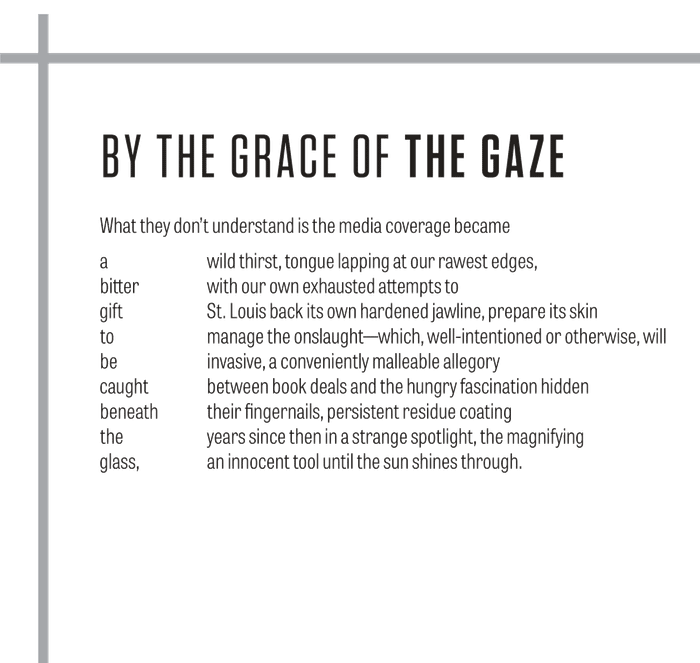
HOW TO MAKE SOUTH GRAND A GHOST TOWN
| On this night, the canister | ||
| landed between my feet, | ||
sprouting a bulbous, billowing white heaven, | ||
| empty of harps & mercy, | ||
| void of any god & uninterested | ||
| in finding one. | ||
| There is a flash of light, | ||
| a sudden moment when | ||
| the whole world is swallowed | ||
| in a bright clap & bang, | ||
| & then is remade piece | ||
| by piece in the moonlight. | ||
| I’m running & the ground | ||
| appears again, the bits of grass | ||
| sprouting like small, fractured | ||
| Edens between the pavement, | ||
| the handful of cars my waist swivels past | ||
| & the night is not over. | ||
| The whole world, | ||
| yes, the whole | ||
| world is here. |
| // | |
|---|---|
The fourth time it happened, I discovered It is a horribly bearable ruin— & rid your flesh of mist, this smoke & the cough breath the cough & breath | Alll of this while blinded. All of this You forgot your burning sockets until the acid drowned, too — streamed down your cheeks your lungs, metronomed your eyelids, your fists, so big & finally |
ON THE CHEMICAL PROPERTIES & USES OF DRIED BLOOD
| Months later, West Florissant is a swollen jaw of chipped teeth. August scratched open Within hours, the whole country’s fist By November, the fist had retreated & with it went palmfuls of blood: | ||
for testing, for study & inspection, | ||
How useful the bleeding, In the fist’s wake was a hollow, |
Selected poems from Bittering the Wound (Autumn House Press, 2022). Reprinted with permission from the author.
Sherell Barbee is the print editor at In These Times where she also curates the culture section. Her previous editorial work includes the Missouri Review, Pleiades magazine, Speilburg Literary Agency and 826 Boston. She was a 2021 residence fellow at the Massachusetts Museum of Contemporary Art.
Jacqui Germain is a journalist and poet living in St. Louis, Missouri. She’s the author of Bittering the Wound, her debut poetry collection about the Ferguson Uprising.
